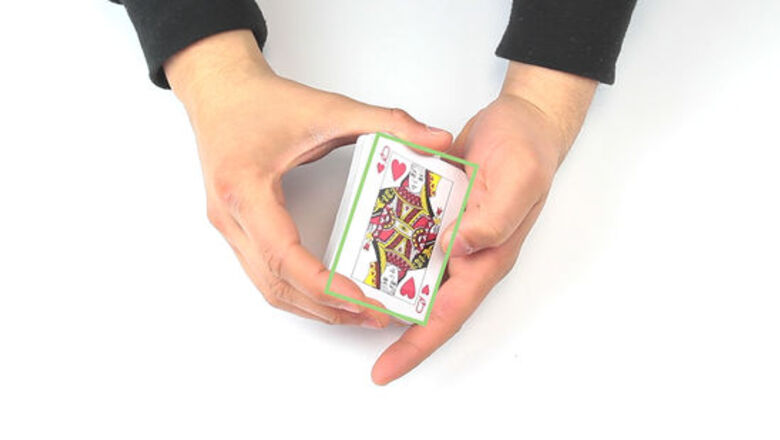
views
Finding Someone's Card in a Deck
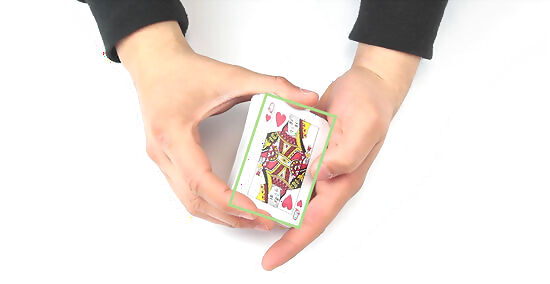
Shuffle the deck and memorize the bottom card. Make a show of shuffling your deck. Part of a successful magic trick involves drawing your audience’s attention somewhere specific. Shuffle the deck once, then let your spectator shuffle the cards or cut the deck to show that the arrangement of the cards is completely random. After they shuffle the deck, memorize the bottom card. One way to do this is to cut the deck as the very last shuffling action you do, then sneak a peek at the bottom card as you tap the cards on the table. Another option is to glance at the bottom card before you go to shuffle the cards one last time. Two methods for making sure the card on the bottom stays on the bottom when shuffling are: When performing a Riffle shuffle, make sure that you always start the shuffle with the hand that has the bottom card in it.This way, your bottom card stays the same as it hits the table first. In an Overhand shuffle, angle the face of the cards away from your audience. Cut the deck, but grip the bottom card with the pads of your fingers. While you separate the deck to shuffle, pull back on the bottom card so it doesn’t get pulled up, but stays on the bottom.
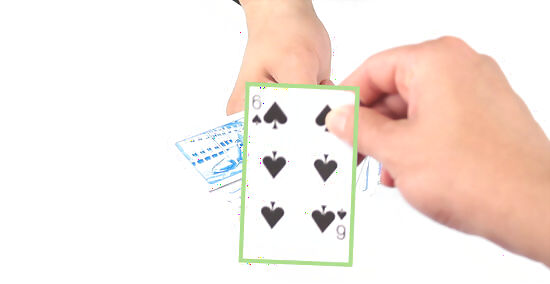
Ask your audience member to pick a card. Have the person memorize it and place it on the bottom of the deck. When your spectator puts the card at the bottom of the deck, it will be right next to the bottom card you've memorized. Make a show of looking away as your spectator memorizes the card. The less it looks like you’re trying to figure out what the card is now, the better your trick will look in the end.
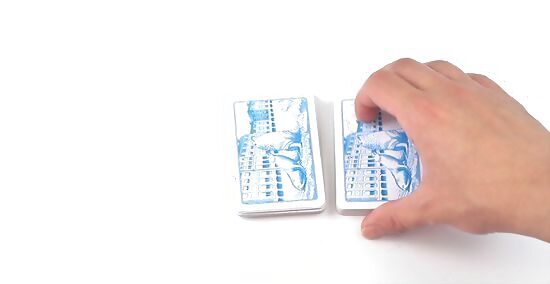
Cut the deck. You can cut the deck yourself, or have the spectator cut it. Your original bottom card which you’ve memorized and your spectator's card will end up somewhere in the middle of the deck. When you turn the deck over and fan them out, the person's card should be on top of, and to the right of the card that you memorized. If you have good sleight of hand, you might want to cut the deck a few times. If you know where your two cards are roughly placed in the deck, you can further cut it, keeping the two cards together.
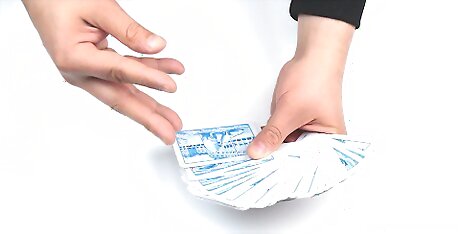
Announce that you will now find your spectator's card. This is your time to bring out the “magic” of the trick. The more you can sell your performance, the more fun the trick will be for your audience. Have fun fanning out your cards, running your hand over the deck as you look for your spectator’s card.
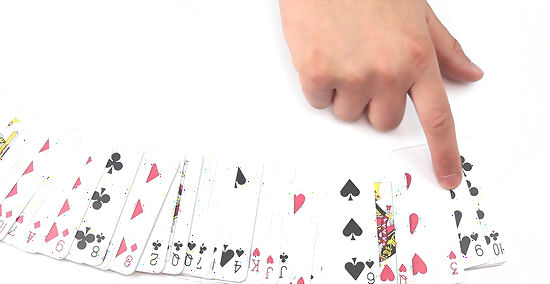
Search for the original card you memorized. Fan through your deck face-up, so that both you and your spectator can see your cards. When you find your original card, you'll know that your spectator's memorized card should be the one on top of it. Once you’ve located it, don’t pick it out right away. Study your spectator as if you can read the answer there. Play around with almost picking other cards, then deciding to move on. Finally, once you’ve built suspension, pick the card your audience member chose.
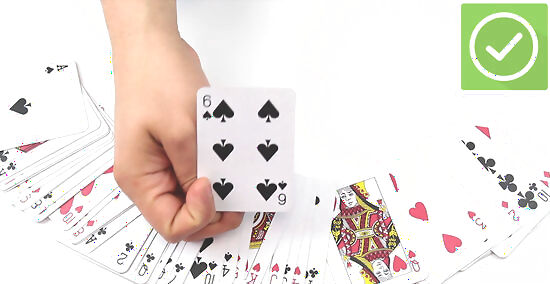
Reveal the card. With a great flourish, show your spectator her card. Ask your audience member if the card you are holding is her card. If it is, congratulations! You’ve performed a basic magic trick. If for some reason it is not her card, you can say something like “There must be an interference in the magical realm.” And attempt the trick again.
Performing the Four Robbers Trick
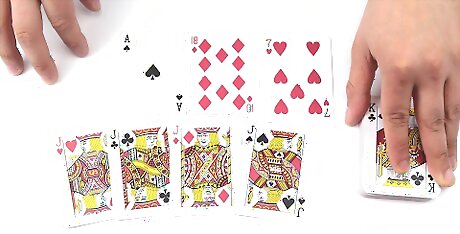
Extract the all four Jacks from the deck. Then take three more random cards from the deck as well. This trick requires that you gimmick the deck a little bit before you start. For the Four Robbers, you're going to make your spectators think you’ve put the Jacks into the middle of the deck. In reality, you’ll place the three other cards you've taken into the deck. These three other cards will be stacked on top of three of the Jacks during the trick. This trick involves a story, begin your story by telling your audience about four Jacks that decided to rob a bank.
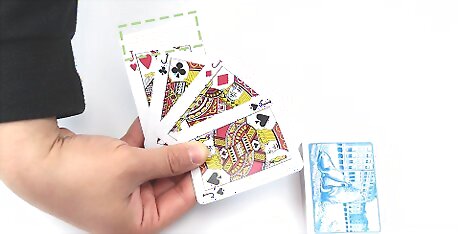
Present the Jacks to the audience. Hold the four Jacks, fanned out vertically in your hand. All four Jacks should be able to be observed by the audience at the same time. Hold the three random cards behind the Jack that’s on top so the audience cannot see them. This is essential to the trick. If you are having trouble hiding the other cards, hold them in place by putting your index finger on the top edge of the cards. Once you have given your audience a bit of time to see the Jacks, square the cards together. For this part of the story, you can say that the four Jacks helicoptered into the bank, or simply snuck in through the roof.

Place the stack of seven cards on top of the deck, face down. Your audience will now believe that the four Jacks are at the top of the deck, which they are. However, your audience will not know there are three other cards on top of the Jacks. Pick the top card off the deck and place it towards the bottom of the deck. This part of the story involves the first Jack running down to the basement (the bottom of the deck) to clear the basement and keep an eye out for cops. Make sure that your audience can’t see the face of the card you are picking up as it is not a Jack. When you pick the card up, do it so the face of the card is toward you and the audience only sees the back of the card.
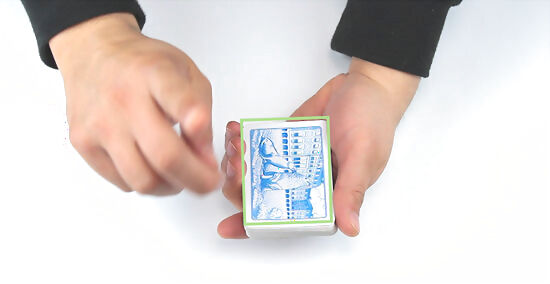
Repeat the process with the next two cards. As you grab the next top card, move up the deck as you place it back in, continuing the story. You can say that the second Jack went to take the money from the tellers, placing it in the middle of the deck. The third bank robber went a little higher up to steal the money in the vault. When you place the third card toward the top of the deck, just make sure not to place it too high so you don’t separate the Jacks.
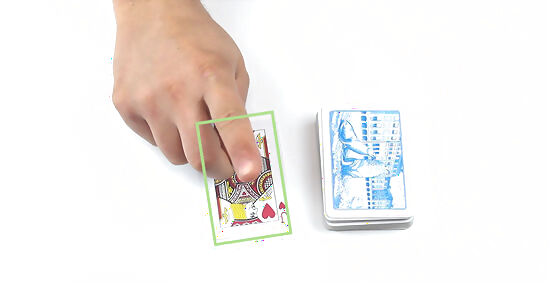
Show the top card as the last Jack. Say that this Jack stays up on the roof to look out for a helicopter. You can show your audience this Jack as it is supposed to be on top of the deck. Note that this will be a different Jack than the one that would be on top if you truly moved the other three somewhere else in the deck. It’s best to match the color of the top and bottom Jacks for this reason.
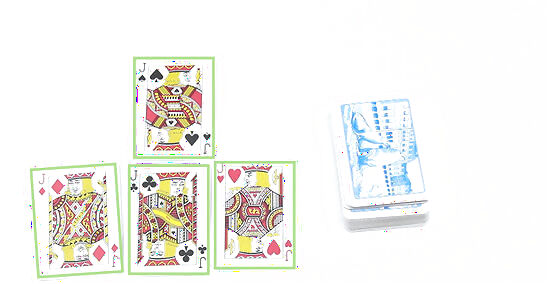
Reveal your four Jacks. To finish the trick, explain how the Jack on the roof saw the police coming and radioed for his friends. Or, the Jack at the bottom saw the police down in the basement and ran up to the roof, taking his friends with him. As you do this, reveal the three other Jacks on top, saying that the Jacks have run up to the roof to escape. Obviously, you know the Jacks have been there the whole time, but the spectators will think the cards magically returned to the top after having been inserted into the bottom and middle of the deck.
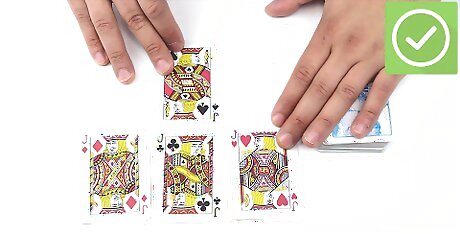
Tell the story. This trick relies on some good storytelling. You can tell the story as if the Jacks are robbing a bank, or about how four robbers entered a house to rob different floors. Take the top three cards of the deck off one at a time, inserting them into the different levels as you tell your story. Tell the story dramatically. The more detail you provide concerning what the Jacks are looking for and what the robbers are planning to do with the cash, the more engaged your audience will be. An immersive story will distract your audience from what you’re doing with your hands. This trick can be performed with any set of face cards, not only Jacks.
Performing the Gambler
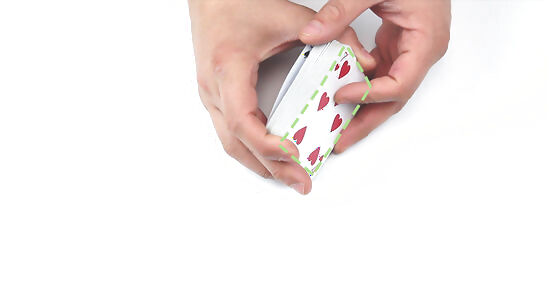
Shuffle the deck thoroughly and memorize the bottom card. You can even let an audience member shuffle or cut the deck to make them less suspicious. Feel free to cut the deck as well. At some point when you're squaring up the deck, sneak a peek at the bottom card and memorize it. If you let an audience member shuffle the deck, just take a quick look at the bottom card of the deck before moving on. This trick is similar to finding someone’s card in the deck, with a slight variation.
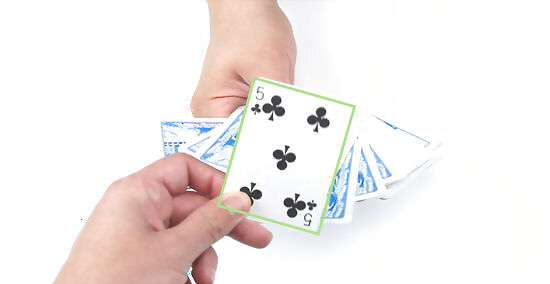
Let your spectator choose any card. Fan out the deck slightly and ask your audience member to pick a card and memorize it. Then, cut the deck from where the card was drawn and separate it into to two piles. Have your audience member place the card on top of the pile that doesn’t have the bottom card you’ve memorized in it. Then place your memorized card on top of your audience member’s card. If you are more advanced, you can perform a swing or false cut which gives the illusion of shuffling the deck without actually doing so.
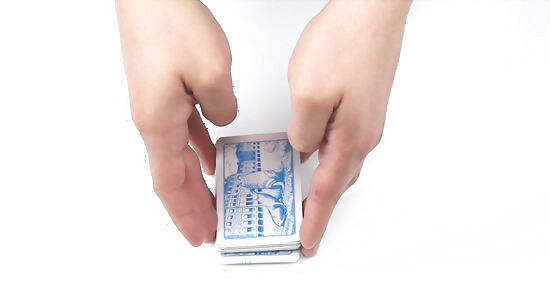
Cut the deck. You can either cut the deck yourself, or have your audience member cut the deck once. Now the bottom card you memorized is right on top of your spectator's chosen card. At this point, you may want to do a few shuffles, but if you do, make sure to remember where the two cards are so you don't mix them up. The more places you find to let your audience interact in your trick, the more the audience feels in control. This will make the reveal at the end of the trick more rewarding.
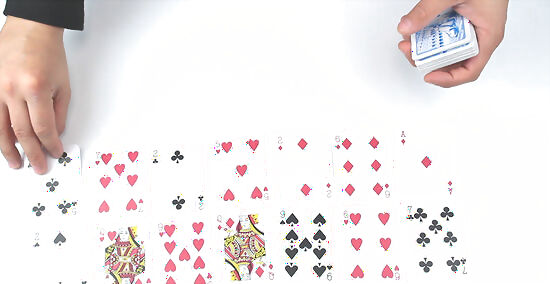
Start dealing the cards out. Deal your cards out in a row from one side of the table to the other. Don't stop when you see the card you memorized and your spectator's chosen card, which is the one right after yours. Keep dealing as if everything is normal. Deal out most of the deck except for the last several cards in this manner. This trick involves you acting as if you already know what your audience member’s card is. If you stop when you do get to it, it will ruin the next parts of the trick.
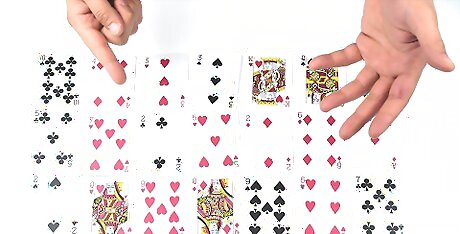
Start running your mouth. Magic tricks, especially this one, are enhanced when you tell a story. Start talking about how you're so convinced you'll find your spectator’s card that you're going to bet money on it. You can even add a bit about how you made a lot of money in Vegas by knowing how to manipulate a deck of cards. Bet a dollar that the very next card you flip over will be the spectator's. Because the spectator already saw the card go by, he might take the bet, thinking that you're about to turn over the final card in your hand. If the audience member doesn’t take the bet, offer a dollar up if you’re wrong.
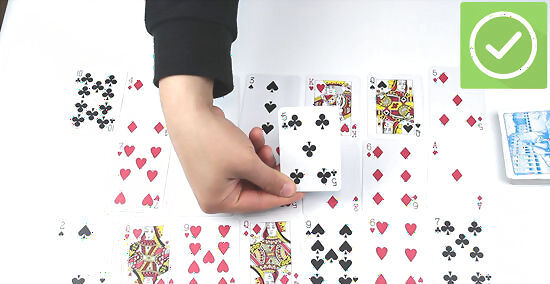
Flip over your spectator's card. Instead of flipping the next card in the deck over, hunt back through the pile of cards you've already turned over and find his card, which should be right next to the card you memorized. To really sell this move, pretend as if you're about to turn over the card in your hand before flipping over your spectator's card. Don’t actually take anyone’s money. If your audience member did bet you, take your dollar back and tell him that you’ll give him this one for free. You can even make a joke out of it by telling him it wouldn’t really be fair since you’re magic and already knew which card was his. If you do mess up the trick, you may have to give your audience member the dollar you staked.
Doing the Hand Sandwich
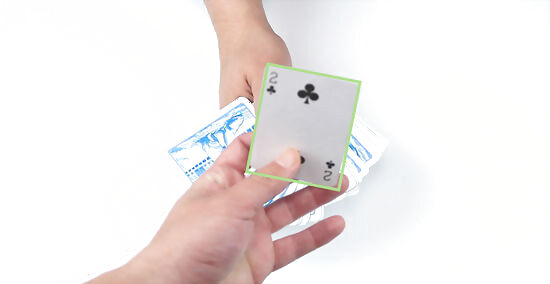
Have a spectator pick a card. Take a regular deck and fan out the cards for a spectator, asking her to pick a card. As your spectator picks the card and memorizes it, cut the deck. Have your spectator place the card on top of the cut and then stack the rest cards into a pinky break. Have the spectator place the card on the bottom half of the deck, keeping a pinky break between her card and the cards you're laying on top. This way, you'll know where the card is. A pinky break is performed by using the padding of your pinky finger to keep a slight cut in the back of the deck that your audience can’t see.
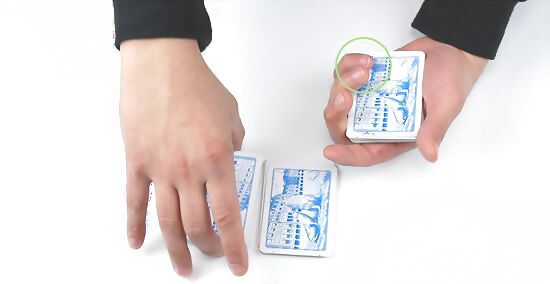
Cut the deck again. Use your pinky break to separate the cards you stacked on top of the spectator's card and cut the deck so your spectator’s card is on the top. This might be an obvious re-cut, so to distract your audience, ask your spectator to concentrate super hard on the card which was drawn, explaining that you’re going to attempt to make the card show up in your spectator’s hands. If you plan to shuffle any more, make sure that the top card stays there.
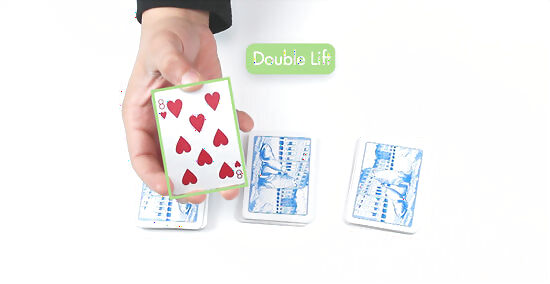
Do a double lift. A double lift involves taking the top two cards off the top as if you only took one. It is an essential sleight-of-hand skill to learn if you want to perform magic card tricks. Show your spectator the face of the card you just took off the deck in the double lift. State that you want your spectator to sandwich this card in between her hands, and that you’re going to magically change it with the one she picked. As you say this, place both cards back on top of the deck. You may need to practice taking the two cards off the top, and showing the face of the second one, as if it were one card before attempting this trick.
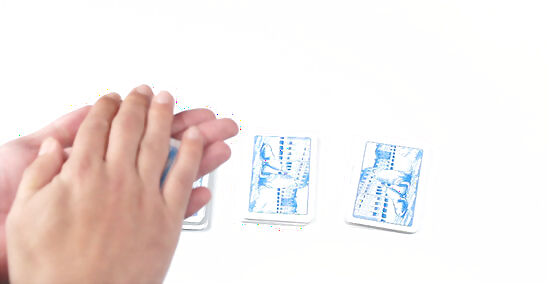
Sandwich your spectator's card. Place the top card which is the one your spectator originally picked on top of her hand, and have her then place her other hand over it. Once you've got the double lift down, put the two cards back on the deck, taking the top card (the spectator’s original card) and putting it into their hands, face-down, sandwiched there. Tell your spectator to hold onto the card tightly, applying a good amount of pressure. At this point, the card your spectator picked is sandwiched between her hands, but she will think it is the card you just showed her. This card is on top of the deck.
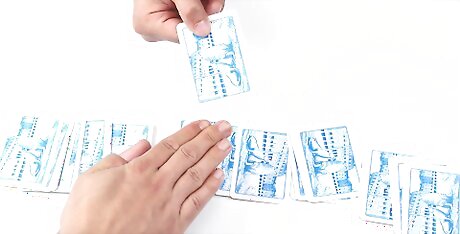
Go looking for the card. Tell your spectator that you're going to switch the card she’s holding right now magically with the card they selected initially. Go hunting around the deck as if you were looking for their card, all the while knowing your spectator already has it. Settle on the card that's already on top of the deck which your spectator thinks is in between her hands.
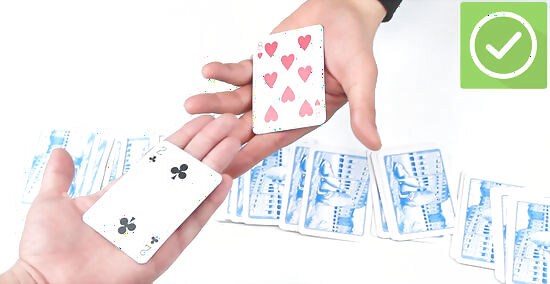
Do the reveal. Finally, reveal that you have the card your spectator believed was in her hands. Ask your spectator to look at the card she has, revealing that it is her original card.


















Comments
0 comment